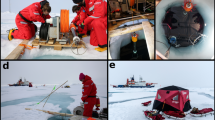Abstract
Argo drifters provide information of the vertical structure in the water column and have a potential for the improvement of understanding phytoplankton primary production and biogeochemical cycles in combination with ocean color satellite data, which can obtain the horizontal distribution of phytoplankton biomass in the surface layer. Our examples show that using Argo drifters with satellite-measured horizontal distribution of phytoplankton biomass at the sea surface allow an improved understanding of the development of the spring bloom. The other possible uses of Argo drifter are discussed.
Similar content being viewed by others
References
Ali, M.M. and R. Sharma. 1994. Estimation of mixed layer depth in the equatorial Indian Ocean using GEOSAT altimeter data.Mar. Geod.,17(1), 63–72.
Behrenfeld, M. and P. Falkowski. 1997. Photosynthetic rates derived from satellite-based chlorophyll concentration.Limnol. Oceanogr.,42(1), 1–20.
Behrenfeld, M. and E. Boss. 2003. The beam attenuation to chlorophyll ratio: An optical index of phytoplankton physiology in the surface ocean?Deep-Sea Res. I,50, 1537–1549.
Claustre, H., A. Morel, M. Babin, C. Cailliau, D. Marie, J.-C. Marty, D. Tailliez, and D. Vaulot. 1999. Variability in particle attenuation and chlorophyll fluorescence in the tropical Pacific: Scales, patterns, and biogeochemical implications.J. Geophys. Res.,104, 3401–3422.
Loisel, H. and A. Morel. 1998. Light scattering and chlorophyll concentration in case 1 waters: A reexamination.Limnol. Oceanogr.,43, 847–858.
Longhurst, A., S. Sathyendranath, T. Platt, and C. Caverhill. 1995. An estimate of global primary production in the ocean from satellite radiometer data.J. Plank. Res.,17(6), 1245–1271.
Morel, A. and J.-F. Berthon. 1989. Surface pigments, algal biomass profiles, and potential production of the euphotic layer: Relationships reinvestigated in view of remote-sensing applications.Limnol. Oceanogr.,34(8), 1545–1562.
Muller, J.L. and R.E. Lange. 1989. Bio-optical provinces of the Northeast Pacific Ocean: A provisional analysis.Limnol. Oceanogr.,34(8), 1572–1586.
Platt, T., S. Sathyendranath, C. Caverhill, and M. Lewis. 1988. Ocean primary production and available light: Further algorithms for remote sensing.Deep-Sea Res.,35(6), 855–879.
Platt, T., C. Caverhill, and S. Sathyendranath. 1991. Basin-scale estimates of oceanic primary production by remote sensing: The North Atlantic.J. Geophys. Res.,96(8), 15147–15159.
Sathyendranath, S., T. Platt, E.P.W. Horne, W.G. Harrison, O. Ulloa, R. Outerbridge, and N. Hoepffner. 1991. Estimation of new production in the ocean by compound remote sensing.Nature,353, 129–133.
Siswanto, E., J. Ishizaka, and K. Yokouchi. 2004. Estimating chlorophyll vertical profiles from satellite data and the implication to primary production in Kuroshio front of the East China Sea.J. Oceanogr.,61, 575–589.
Son, S., J. Campbell, M. Dowell, S. Yoo, and J. Noh. 2005. Primary production determined by ocean color remote sensing in the Yellow Sea.Mar. Ecology Prog. Ser.,303, 91–103.
Sverdrup, H.U. 1953. On conditions for the vernal blooming of phytoplankton.J. Cons. Int. Explor. Mer.,186, 287–295.
Yan, X.-H., J.R. Schubel, and D.W. Pritchard. 1990. Oceanic upper mixed layer depth determination by the use of satellite data.Remote Sens. Environ.,32(1), 55–74.
Author information
Authors and Affiliations
Corresponding author
Rights and permissions
About this article
Cite this article
Son, S., Boss, E. & Noh, J.H. Potential of Argo Drifters for Estimating Biological Production within the Water Column. Ocean Sci. J. 41, 121–124 (2006). https://doi.org/10.1007/BF03022417
Received:
Revised:
Accepted:
Issue Date:
DOI: https://doi.org/10.1007/BF03022417




